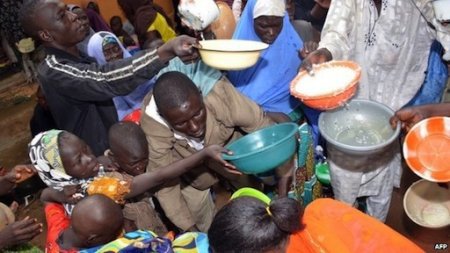The Global food agencies have warned that about 3.8 million people in 16 northern states of Nigeria and the Federal Capital Territory (FCT) may face acute starvation.
The agencies, which include UN Food and Agriculture Organisation (FAO) and World Food Programme (WFP), listed the 16 states as Bauchi, Benue, Gombe, Jigawa, Plateau, Niger, Kebbi, Katsina, Kaduna, Taraba, Zamfara, Sokoto, Kano, Yobe, Borno and Adamawa.
The agencies issued the warning on Thursday in Abuja at a meeting for the presentation of the results of the March 2018 Cadre Harmonisé (CH) analysis of food and security situation in Nigeria.
The CH report said that judging from the current situation in the 16 states and FCT, more than 3.8 million people might face acute food shortage if tangible efforts were not made to address the situation between June and August, the next lean period.
“More than 10 million people were analysed and over 3.8 million people need urgent attention of food, while it was projected that 5.8 million people would face extreme food and nutrition deficits.
“Most of the analysed households have food stocks that may last only few months before the lean period of June to March and they need urgent attention for the situation not to get out of hand,’’ it said.
The report said that the analysis was based on four conceptual frameworks, which included food security, nutrition, livelihoods and mortalities.
It noted that the results of the analysis indicated that three local government areas (LGAs) in Adamawa, including Michika and Madagali LGAs, and another three LGAs in Borno were currently experiencing severe food crisis.
The report said that food availability was extremely limited in the areas because there had been no food production in the areas in the last three years. It said that household and market food stocks had been depleted in the affected areas, while the residents had no access to markets.
It said that the development was as a result of the Boko Haram insurgency and the persistent farmers-herdsmen clashes in the region.
“Four local government areas in Yobe, two in Zamfara, two in Gombe and the central area of Kaduna may go into food crisis if the situation is not properly handled. “Besides, one local government area in Katsina State is under food pressure and two more local government areas are likely to be under food pressure, going by projection,’’ it said.
It, however, noted that the food security in Benue was not under pressure in spite of the persistent clashes between farmers and herdsmen in the state.
The report said that at present, Kano, Kebbi, Bauchi states and part of Gombe State were not experiencing food crisis but it warned that the present situation was not enough to conclude that the states were crisis-free.
It said that the analysis in Plateau and Niger as well as FCT was inconclusive because there were no adequate data to work with. It noted that after studying those people affected by food insecurity, one of the recommendations aimed at addressing the situation was to strengthen their access to food.
Speaking, Myrta Kaulard, WFP Country Representative, commended the results of the analysis after comparing them with the 2017 results. “It is estimated then that 5.7 million people would be very food insecure and there was big global food security support; by October 2017, the number was halved to 2.5 million people.
“This is an incredible result and it is unique in terms of engagement by the stakeholders. “The estimate is that by June to July 2018, 3.7 million people will be food secure. It looks good but the main message is that food assistance is very important as it would improve the situation; therefore, all the stakeholders must continue their engagement,” she said.
Kaulard said that WFP would sustain its programmes until the affected people became self-sufficient in food production, while having hitch-free access to seeds and helping themselves to survive and get out of food assistance.
Suffyan Koroma, the FAO Country Representative in Nigeria, said that CH was the current regional framework for consensual analysis of acute food insecurity situations.
He said that it was aimed at applying the results of food insecurity analysis to prevent food crisis by identifying affected areas and populations, while proffering appropriate measures to improve their food and nutrition security and livelihoods.
Mr. Koroma said that the results of the analysis, which identified food and nutrition insecure areas within the 16 states and the FCT, were arrived at after analysing the food and nutrition security outcome indicators and their relevant contributing factors.
He said that the results of the CH analysis indicated that a proportion of the population had drifted from the higher CH phases (4 to 5) of food insecurity to lower phases (1 to 3)




